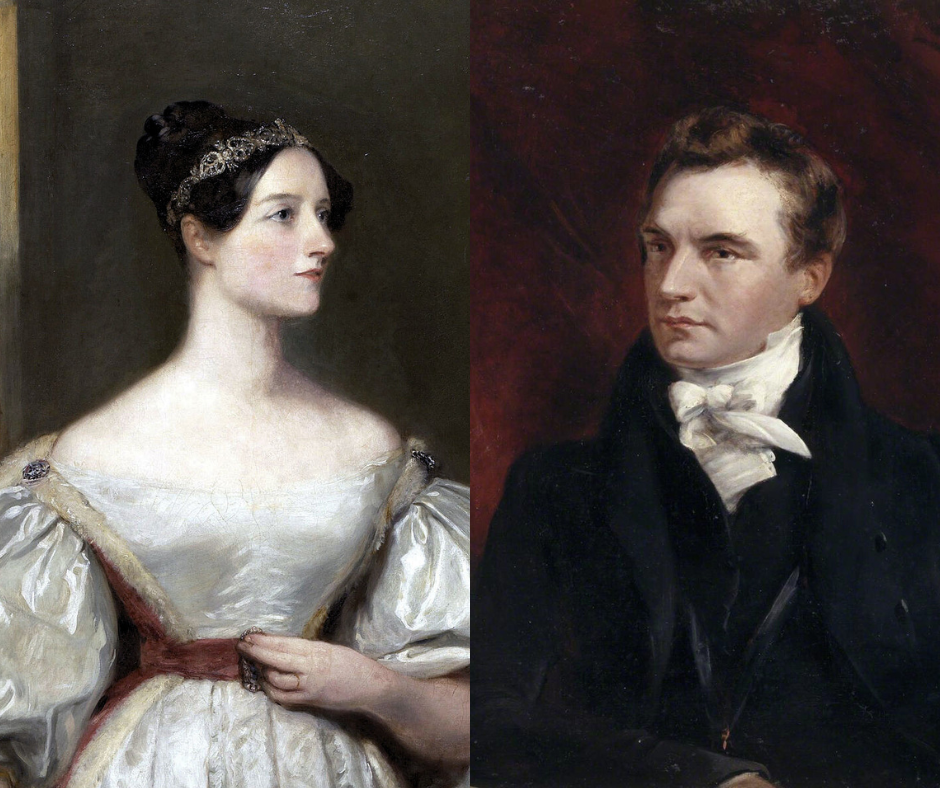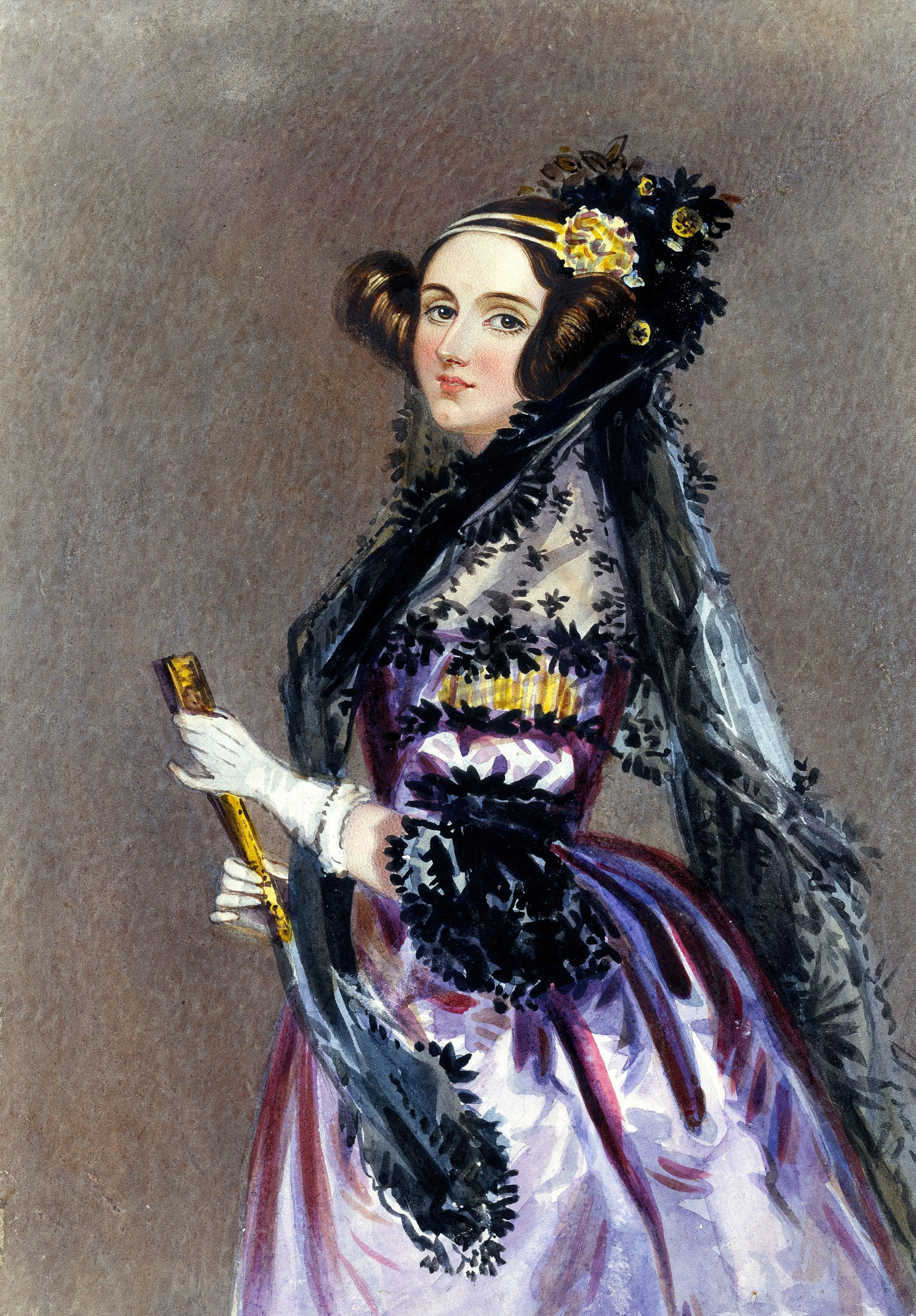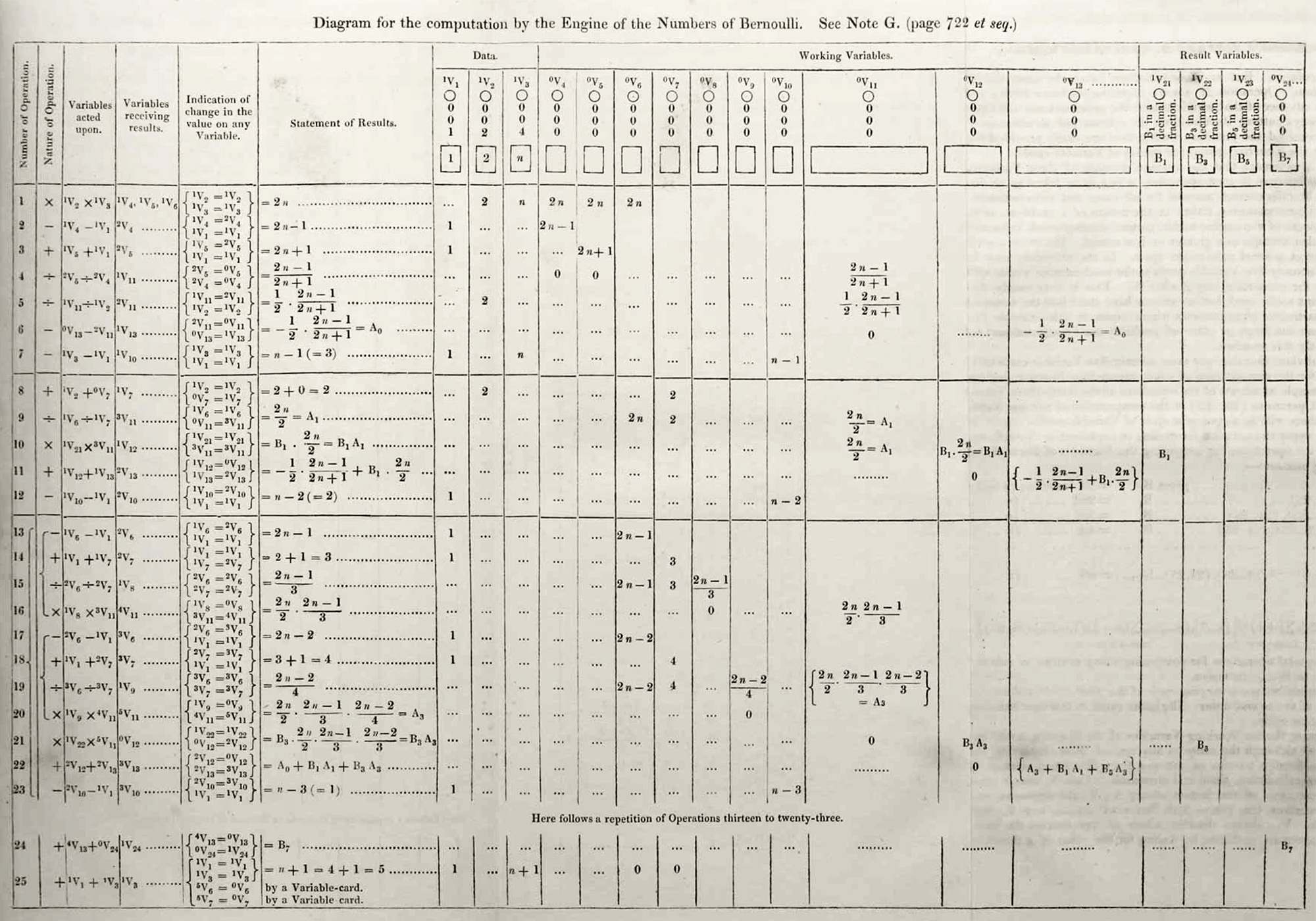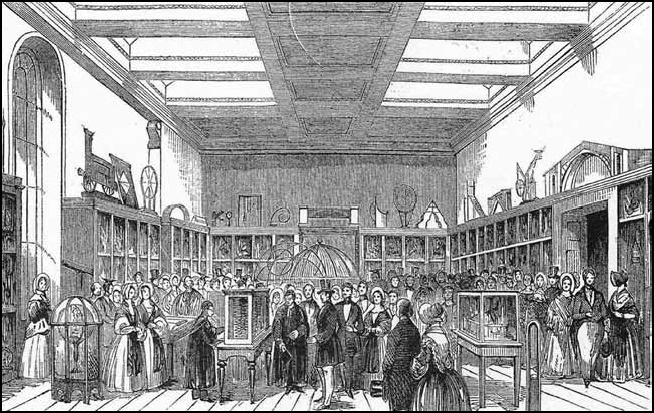
Exploring the Collaborative Relationship Between Ada Lovelace and Charles Babbage
Summary
Reflection Questions
Journal Prompt
A pair of pioneering inventors and mathematicians, Charles Babbage and Ada Lovelace enjoyed a meaningful collaborative relationship. They shared a rich intellectual exchange in which Lovelace not only understood Babbage’s designs but also added her own insights. Unfortunately, their joint venture (the Analytical Engine) was never completed in Babbage’s or Lovelace’s lifetime. However, their ideas laid the groundwork for modern computing. Ada Lovelace is now celebrated for her pioneering work in the field, and her contributions are recognized annually on Ada Lovelace Day, an event that highlights women’s achievements in science, technology, engineering, and mathematics (STEM). Read on to learn more about how the world’s first computer programmer collaborated with longtime friend Charles Babbage throughout their lifetimes.
Background on Ada Lovelace

Ada Lovelace was born Augusta Ada Byron (later Augusta Ada Lovelace) on December 10, 1815. Ada’s birth resulted in the only legitimate child of the famous Romantic poet Lord Byron and his wife, Annabella Milbanke Byron, who was herself a highly educated and intellectual woman. Ada’s upbringing was steeped in an environment that valued education, particularly in the fields of logic and science, a stark contrast to the poetic and often tumultuous world of her father.
Her mother, Lady Byron, perhaps in reaction to Lord Byron’s unpredictable and artistic temperament, focused on guiding Ada towards the study of mathematics and logic. Lady Byron wished that Ada would pursue important disciplines like math and science rather than her husband’s pursuits, which she considered frivolous.
This educational approach was quite progressive for the era, particularly for a young woman. Ada’s curriculum included studies in mathematics and science, unusual for women of her time, and she was tutored by notable academics, including Mary Somerville, a renowned scientist and mathematician of the day.
Ada later became the Countess of Lovelace through her marriage to William King, who was made Earl of Lovelace in 1838. When Ada married William King in 1835, he was a nobleman with the title of Lord King. Upon his elevation to an earldom, Ada King, as his wife, assumed the courtesy title of Countess of Lovelace. As Countess of Lovelace, Ada continued her work in mathematics and computer science, and today, she is remembered more as the first computer programmer than for her title.
Early Interest in Mathematics and Science

From an early age, Ada showed a proclivity for numbers and scientific inquiry. Her fascination with machinery and the analytical side of mathematics was evident. She was captivated by the idea of flying, which led her to study bird anatomy and to conceptualize a flying machine at the age of just 12. This project, which she described as “The Flyology,” demonstrated her early ability to blend creativity with scientific and mathematical principles.
Ada’s mother encouraged her scientific interests, seeing them as a way to prevent her daughter from developing the perceived moodiness and unpredictability of her father. Ada’s ongoing education was marked by the study of advanced topics in mathematics and sciences, setting a solid foundation for her future contributions to the field of computing. This early exposure to and passion for mathematics and scientific methods significantly shaped her later work and collaborations, particularly with Charles Babbage.
Background on Charles Babbage

Charles Babbage, born on December 26, 1791, in London, was a mathematician, inventor, and mechanical engineer, whose work has earned him the title of ‘father of the computer’ in recognition of his contributions to the basic design of the computer through his early mechanical general-purpose computing machines.
His academic journey began at Trinity College, Cambridge, in 1810, where he found the mathematical instruction unsatisfactory. His response to this was to help form the Analytical Society, which aimed to reform the mathematical curriculum at Cambridge. Babbage was a polymath with a penchant for mathematics and engineering, and he held the Lucasian Chair of Mathematics at Cambridge from 1828 to 1839.
His career was marked not only by his academic prowess but also by his pursuits in various scientific and technological endeavors. He played a significant role in the establishment of the Astronomical Society in 1820 and the Statistical Society in 1834. Babbage’s broad interests and foundational work in various fields, including what would become computer science, set the stage for his development of early computational ideas.
Development of Early Computational Ideas
Babbage’s journey towards developing early computational machines began with his conceptualization of the Difference Engine in the 1820s. This machine was intended to automate the process of calculating mathematical tables, a task traditionally done by human computers. The Difference Engine was designed to compute a series of values automatically and print the results, thereby reducing the risk of human error in mathematical calculations.
However, due to funding issues and technical challenges, the full engine was never completed in his lifetime. Undeterred, Babbage moved on to a more ambitious project, the Analytical Engine, in the 1830s. This machine is considered the forerunner of the modern computer. Unlike the Difference Engine, which was designed for a specific function, the Analytical Engine was conceptualized as a general-purpose computing machine. It was designed to be programmable using punched cards, an idea borrowed from the textile industry’s Jacquard loom.
The Analytical Engine comprised various elements that are fundamental to modern computers, including a control unit and a memory. While Babbage’s ideas were far ahead of the technology available at the time, and the Analytical Engine was never built, his designs laid the groundwork for the development of modern computers.
A Meeting of Mathematical Minds
The historic meeting between Ada Lovelace and Charles Babbage occurred in 1833, at a party hosted in London. At this time, Ada was 17 years old and already had a deep fascination with mathematics and science. Babbage, 41 years old, was already well-established in his scientific and mathematical career.
The meeting was facilitated by Mary Somerville, a Scottish scientist and mutual acquaintance who recognized the potential synergy between Lovelace’s mathematical acumen and Babbage’s inventive genius. This introduction was the beginning of a profound intellectual partnership and friendship that would leave a lasting impact on the fields of mathematics and computer science.
Initial Impressions and Shared Interests
The initial interaction between Lovelace and Babbage was marked by mutual respect and intellectual curiosity. Lovelace was captivated by Babbage’s ideas and his work on his innovative computing machines. Babbage, on his part, was impressed by Lovelace’s sharp intellect and understanding of mathematics, which was unusual for women of that era.
They found common ground in their shared interests in mathematics, logic, and the potential of technology. This mutual respect and intellectual alignment set the stage for their subsequent collaboration. Babbage was particularly struck by Lovelace’s insight and the depth of her analytical skills, which were remarkable given her young age and the limited educational opportunities generally available to women at the time.
The Beginning of Their Collaboration
The collaboration between Lovelace and Babbage began after their initial meeting and continued over the years. Lovelace took a keen interest in Babbage’s work on the Analytical Engine, a mechanical general-purpose computer. She understood not only the mechanical workings of the machine but also its theoretical implications.
In 1842, Lovelace translated an article written by Italian mathematician Luigi Menabrea on the subject of the Analytical Engine. Her translation, more significantly, included what Lovelace wrote in her own elaborate notes, which extended far beyond the scope of the original article.
Ada Lovelace’s notes contained what is now considered one of the earliest algorithms intended for machine processing. This marked the start of her legacy as a pioneer in computer programming. The partnership between Lovelace and Babbage was one of mutual respect and intellectual stimulation, with Lovelace providing insights that extended Babbage’s computational ideas into new theoretical realms.
Babbage and Lovelace’s Collaboration on the Analytical Engine

The Analytical Engine, initially conceived by Charles Babbage, marked a significant milestone in the history of computing. It was an ambitious step beyond his earlier work, the Difference Engine. Conceived in the 1830s, the Analytical Engine was designed as a general-purpose computing machine, far ahead of its time.
It was intended to perform any mathematical calculation, using a form of physical memory and a central processing unit, a concept that is fundamental in modern computing. The engine was to be powered by steam and would use punch cards for input and output, an idea inspired by the Jacquard loom used in textile manufacturing.
Despite its groundbreaking design, the Analytical Engine was never completed during Babbage’s lifetime, largely due to technological limitations and funding issues. However, the ideas and designs behind the Analytical Engine laid the groundwork for the future development of computers.
Lovelace’s Role and Contributions
Ada Lovelace’s role in the development of the Analytical Engine was primarily theoretical but profoundly influential. She foresaw the machine’s potential to handle complex operations and to manipulate symbols in accordance with rules, a fundamental aspect of programming. Lovelace’s insights into the machine’s potential applications showed remarkable foresight into what computing machines could eventually become.
Her Translation of Luigi Menabrea’s Article
Lovelace’s significant contribution to Babbage’s work began with her translation of an article by the Italian engineer Luigi Menabrea, which described the Analytical Engine. This translation, completed in 1843, was a pivotal moment in her career. Menabrea’s article provided a detailed account of Babbage’s work, but Lovelace’s translation made this work accessible to the English-speaking scientific community, thereby broadening its impact.
Lovelace’s Annotations and the First Algorithm
More important than her translation were Lovelace’s annotations to Menabrea’s article. These notes, which were three times longer than the original article, contained her own ideas and expansions on Babbage’s concepts. Among these annotations was what is considered the first algorithm ever specifically tailored for implementation on a computer.
This algorithm was designed for the Analytical Engine to compute Bernoulli numbers, a complex sequence of rational numbers. Lovelace’s algorithm demonstrates her understanding of how the engine could be programmed, a concept that was revolutionary at the time. It is considered the first computer program in history.
The Significance of Their Joint Work
The collaboration between Ada Lovelace and Charles Babbage holds a significant place in the history of computing. While Babbage provided the foundational designs of the Analytical Engine, Lovelace’s contributions laid the theoretical groundwork for computer programming. Her vision extended beyond the mechanical computation of numbers, conceptualizing a future where machines could manipulate symbols and process information in ways akin to modern computers.
Their joint work, though not fully realized in their lifetimes, was a critical step towards the development of modern computing, and Lovelace’s contributions especially highlight the role of women in the early history of computing. This collaboration stands as a testament to the power of interdisciplinary partnership in advancing technological innovation.
A Closer Look at the Dynamics of Lovelace and Babbage’s Relationship
The intellectual partnership between Ada Lovelace and Charles Babbage was characterized by mutual respect and a shared enthusiasm for scientific and mathematical inquiry. Despite the differences in their ages and social positions, their relationship was firmly rooted in a common intellectual ground. Lovelace’s aristocratic background and her status as a countess were in stark contrast to Babbage’s more middle-class upbringing and academic career.
However, these social differences did not impede their collaboration. Their correspondence reveals a deep mutual respect: Babbage referred to Lovelace as “The Enchantress of Numbers,” acknowledging her mathematical talent, while Lovelace showed a keen interest in Babbage’s work, often challenging his ideas and providing her own insights. This dynamic enabled a fruitful exchange of ideas, allowing both to explore the potential of computational machines beyond their immediate technological limitations.
Mutual Influence on Each Other’s Work
The partnership between Lovelace and Babbage had a significant impact on their respective works. Lovelace’s most notable contribution was her work on the Analytical Engine, where she not only translated Luigi Menabrea’s article but also added extensive notes that included the first algorithm designed for machine processing.
Her insights predicted future developments in computing, including the idea that machines could manipulate symbols and not just numbers. Babbage, on his part, provided the technical foundation and the visionary ideas that inspired Lovelace’s work. He valued her contributions and often discussed complex aspects of his inventions with her, indicating a level of intellectual trust and collaboration that was quite rare for a woman in the Victorian era.
Challenges and Limitations of Their Collaboration
Despite the fruitful nature of their partnership, Lovelace and Babbage faced several challenges and limitations. The primary challenge was the technological limitation of their time. The Analytical Engine, around which much of their collaboration revolved, remained a concept and was never fully realized. Financial constraints and the technological limitations of the era made the construction of such a complex machine impossible.
Moreover, societal norms and Lovelace’s health issues (she suffered from various health problems throughout her life) also posed constraints. Lovelace’s role as a woman in a male-dominated scientific community of the 19th century meant that her contributions were often under-appreciated during her lifetime. Despite these challenges, the intellectual partnership between Lovelace and Babbage was groundbreaking and laid important groundwork for the future of computing.
Lovelace’s Legacy and Babbage’s Later Years
Ada Lovelace’s contributions to the field of computing were not fully appreciated during her lifetime but have gained significant recognition posthumously. Her work on the Analytical Engine, particularly her notes and the algorithm for calculating Bernoulli numbers, highlighted her understanding of the machine’s potential and her foresight into future applications of computing. This work has led many to regard her as the first computer programmer.
In recognition of her contributions to the field of technology, the U.S. Department of Defense named a newly developed computer language ‘Ada’ in 1980. The Ada programming language was designed with the intent of creating a standardized, high-level language for military applications. Lovelace’s recognition has grown over time, with various awards, scholarships, and events named in her honor, including the annual Ada Lovelace Day which celebrates women’s achievements in science, technology, engineering, and mathematics (STEM).
Charles Babbage’s Continued Work and Legacy
Charles Babbage continued to work on his computational ideas and inventions until his death in 1871. Ada Lovelace died on November 27, 1852, long before Babbage. Although he never saw the completion of his most ambitious project, the Analytical Engine, his work laid the foundational concepts for modern computing.
Babbage also made contributions in other areas, including the economy (he wrote on the cost of manufacturing), and cryptography. His legacy is one of a visionary who conceptualized the principles of a digital computer long before the technology to build such a machine was available. Babbage is remembered as a pioneer in the field of computing, and his ideas have been revisited and celebrated as precursors to modern computational theory and practice.
The Impact of Their Collaboration on Future Generations
The collaboration between Ada Lovelace and Charles Babbage has had a lasting impact on the field of computing and on future generations. Their work together, particularly Lovelace’s theoretical exploration of Babbage’s machine, laid the groundwork for the development of the computer. Lovelace’s vision of a machine capable of more than just numerical calculations predicted the versatility of modern computers.
Their combined legacy is a testament to the importance of interdisciplinary collaboration and forward-thinking in science and technology. The story of their partnership continues to inspire those in STEM fields, particularly women and girls, by highlighting the critical contributions of women in the development of technology. Their work stands as a reminder of the potential of intellectual collaboration to transcend the limitations of the present and envision transformative technologies.
Final Thoughts on the Profound Partnership Between Charles Babbage and Ada Lovelace
The intellectual partnership between Ada Lovelace and Charles Babbage was a confluence of vision and expertise that significantly contributed to the foundations of modern computing. Lovelace, often celebrated as the first computer programmer, brought a unique perspective to Babbage’s groundbreaking designs, envisioning a future where machines could manipulate symbols and perform tasks beyond mere calculation.
Babbage, with his design of the Analytical Engine, laid down the early principles of a digital computer, an achievement far ahead of his time. Their collaboration highlights the importance of interdisciplinary work and mutual intellectual respect in driving scientific advancement. The legacy of Lovelace and Babbage extends beyond their individual contributions.
It serves as a powerful example of how collaborative efforts can transcend the boundaries of current technology and thought, paving the way for future innovations. Their story remains a poignant reminder of the profound impact that collaboration can have in the realm of scientific and technological progress, inspiring future generations to build upon the foundations laid by those who dared to envision the future.








